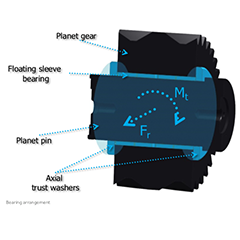In recent years, manufacturers for wind turbine gearboxes have been challenged with high expectations from OEMs to continuously increase torque density and reduce costs. As rotor sizes have increased, rotational speed has decreased (in view of tip speed limitations related to noise) and design torque for the gearbox has increased proportionally. In view of transport, handling, and assembly limits, gearbox manufacturers are confronted with the need to design higher torque gearboxes in the same design space as previous generations of wind turbines. This explains the growing need for torque density increase, i.e. the ability to transfer higher torque levels through the same outer dimensions.
In order to increase the Nm/kg and reduce the €/kNm, ZF Wind Power has assessed several approaches to increase gearbox torque density, which enables the company to develop gearbox solutions for higher torque levels. Measures must be taken on different components to increase overall gearbox loadabililty within the specified outer dimensions. This starts with the gear component loadability, but also includes loadability of the bearings as well as castings and connections. In recent years, ZF Wind Power has managed to increase gearbox torque density from 105 Nm/kg to 175 Nm/kg. Plain bearing technology is an important contributor in this torque density increase.
Challenges to tackle
ZF Wind Power has been working on developing plain bearing concepts as a viable alternative to roller bearings since 2011. A broad study of plain bearing design concepts and materials suitable for different positions in the gearbox was done. It soon became clear that plain bearings are a contributor to the anticipated need for torque density increase as well as cost reduction.
The main challenge, however, is to find the right choice of materials and design parameters to guarantee smooth operation in all wind turbine loading conditions. Whereas most of the known plain bearing solutions run at a rather constant high speed and relatively low load conditions, the wind turbine loading conditions are quite the opposite, i.e. rather high load in combination with relatively low rotational speed, and a combination of transient conditions, such as start-stops, load reversals, etc.
The main challenges are in the low-speed planetary stage, where the combination of relatively low speeds and the flexible surrounding components can bring the plain bearing into mixed friction conditions.



























